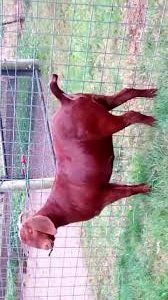The Red Goat THE BEST 'dairy cow'

The Kalahari Red Goat is a meat-type goat breed that began in South Africa. The namesake originates from the Kalahari desert, which traverses the fringes of Botswana, South Africa, and Namibia. This semi-parched atmosphere has added to Kalahari's general toughness. Albeit guided by specific rearing, regular determination assumed a noteworthy part in the improvement of this breed. These are especially sun, parasite, and sickness safe domesticated animals.
These ascribes accumulate to a low work force activity. Their skin is completely pigmented, enabling them to rummage and increment increases through the warmth of the day. They will feast upon a vast assortment of plants for sustenance. Their parasite and sickness opposition takes into account less immunization vaccination than the normal goat breed. This brings down costs, measure of work, and takes into consideration more noteworthy simplicity of a natural undertaking.

Does are known to be incredible in maternal senses, for the most part with no help required for parturition. They have full and legitimately appended udders, and children have solid sucking senses. Cans be reared lasting through the year, and can kid around three times at regular intervals.
The Red Goat of MARADI: the ‘dairy cow’ of the poor
Equalization, artfulness and congruity of frame and shading are the physical highlights passed on by the little red goat of Maradi. It remains the mainstay of the monetary improvement of rustic family units for the nature of its skin looked for in the metropole, and also for its productivity with 2-3 kids for every litter and its drain generation. Thusly, WAAPP has encouraged the dispersal the 'dairy cow of poor people' to help little makers.
It is found in the focal piece of Niger, particularly in the Maradi Department. The red goat is extremely productive as it can bring forth 2 or 3 kids or even 4 now and again. It is likewise early, in light of the fact that its first birthing happens somewhere in the range of 6 and 7 months. It is likewise a decent drain creating creature which can give 0.6 l of drain for every day for two times of 3 to 4 months because of the way that it is calving two times per year. Its drain is wealthy in Vitamin An and is splendidly edible, especially by youthful youngsters. This drain is outstanding in our towns, the same number of maternal vagrants survived on account of goat's drain. The meat of the red goat is delicious and delicate. The corpse yield is assessed at 45-half.
Be that as it may, its global notoriety comes for the most part from its skin which is fine, adaptable and astoundingly strong. In this manner, this skin is profoundly looked for after in extravagance calfskin merchandise. The nature of its skin brought about its spread outside the first region.
The creature is agreeable, genuinely slim, estimating 0.62 to 0.67m and measuring 30 to 35 kg in adulthood. Its horns are decently created and its ears are standing on a level plane and now and again hanging. This creature has a high rusticity. The deciding attributes of the red goat of Maradi are as per the following: normal size, with short and erect ears, two horns (more created in the male) slanted in reverse, short hair, the nearness of goatee (created in the male) in both genders, the nearness of pendants in a few people of both genders, particularly in the East of Maradi (Tessaoua).
As indicated by Prof. Marichatou Hamani, Teacher and Researcher at the Faculty of Agronomy of the Université Abdou Moumouni in Niamey et al. (2012), "the name 'red goat of Maradi' appears to constrain the increases of the breed. It is smarter to state the goat of Maradi and determine that it has three hues: red, dark and darker. The body estimations of this creature differ contingent upon nature. The phenotypic changeability in estimate in the breed offers breed determination potential outcomes in light of ranchers' desires. This produces homogeneous populaces on which crosses with different breeds can be considered."
In Niger, the experts immediately saw the requirement for the protection, change and scattering of this breed. In this way, they built up the Center Secondaire d'Elevage Caprins [Secondary Center for Goat Breeding] in 1963 on 1,850 hectares in Maradi (630 km east of Niamey). This open establishment goes for choosing and dispersing the red goat outside its legitimate unique region that is the Katsina-Maradi district. It additionally goes for sharpening ranchers on adjusted domesticated animals methods. With this discharge arrangement, the red goat is currently present in numerous parts of Niger. Hence, as per the declarations we have gathered from raisers in the bureau of Balleyara (Tillabéry locale), red goats are not eccentric as far as feed since they eat for all intents and purposes all types of herbs in our general vicinity and family unit squander.
As a feature of the collaboration between WAAPP nations, Côte d'Ivoire, Burkina Faso and Mali gained several red goats of Maradi.